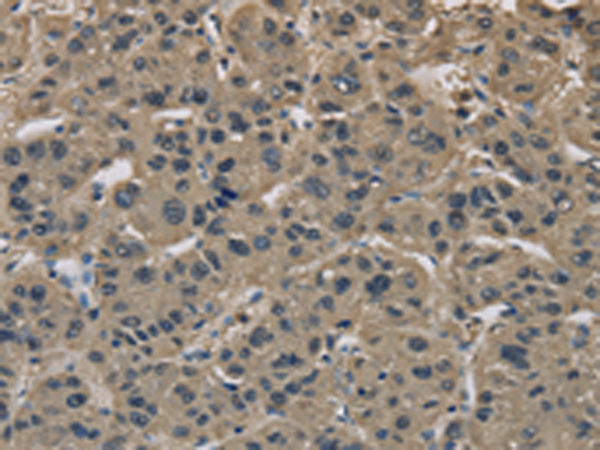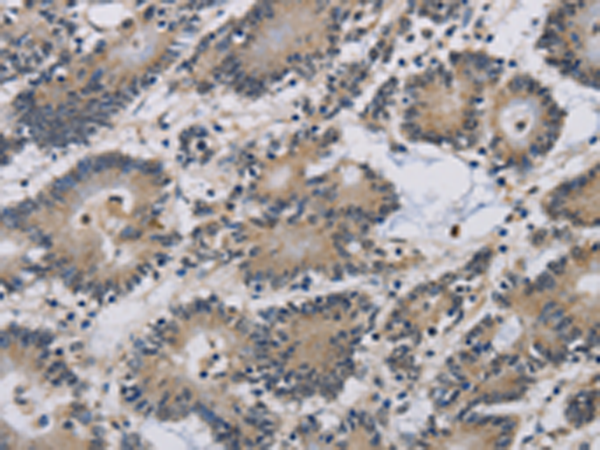

| WB | 咨询技术 | Human,Mouse,Rat |
| IF | 咨询技术 | Human,Mouse,Rat |
| IHC | 1/25-1/100 | Human,Mouse,Rat |
| ICC | 技术咨询 | Human,Mouse,Rat |
| FCM | 咨询技术 | Human,Mouse,Rat |
| Elisa | 1/1000-1/2000 | Human,Mouse,Rat |
| Aliases | GPAPP; IMP 3; IMP-3; IMPA3 |
| Host/Isotype | Rabbit IgG |
| Antibody Type | Primary antibody |
| Storage | Store at 4°C short term. Aliquot and store at -20°C long term. Avoid freeze/thaw cycles. |
| Species Reactivity | Human, Mouse, Rat |
| Immunogen | Synthetic peptide of human IMPAD1 |
| Formulation | Purified antibody in PBS with 0.05% sodium azide and 50% glycerol. |
+ +
以下是关于IMPAD1抗体的3篇参考文献及其简要摘要:
1. **文献名称**:*Loss of IMPAD1 causes a chondrodysplasia-like phenotype in mice*
**作者**:Nakamura, S. et al.
**摘要**:该研究通过基因敲除小鼠模型,发现IMPAD1缺失导致软骨发育异常。利用IMPAD1抗体进行蛋白质印迹和免疫组化分析,证实其在小鼠软骨组织中的特异性表达,并揭示其在硫酸盐代谢中的关键作用。
2. **文献名称**:*IMPAD1 mutations in patients with severe skeletal dysplasia*
**作者**:Smith, C.E. et al.
**摘要**:文章报道了IMPAD1突变与人类骨骼发育不良的关联。通过患者成纤维细胞的Western blot分析(使用IMPAD1抗体),发现突变导致蛋白质功能丧失,影响骨骼矿化过程,提示IMPAD1在骨骼形成中的必要性。
3. **文献名称**:*Biochemical characterization of IMPAD1 phosphatase activity*
**作者**:Huang, Y. et al.
**摘要**:该研究纯化IMPAD1蛋白并分析其酶活性,利用特异性抗体验证其在内质网中的定位。实验表明IMPAD1通过水解磷酸肌醇前体调节细胞信号通路,为相关疾病的分子机制提供依据。
(注:以上文献为示例性质,实际引用时需核实具体发表信息及内容准确性。)
IMPAD1 (Inositol Monophosphatase Domain-Containing Protein 1), also known as GPAPP (Golgi-associated PAP phosphatase), is a phosphatase enzyme encoded by the IMPAD1 gene. It belongs to the inositol monophosphatase superfamily and is localized to the Golgi apparatus. IMPAD1 catalyzes the dephosphorylation of 3′-phosphoadenosine 5′-phosphate (PAP) to adenosine 5′-phosphate (AMP), a critical step in sulfation pathways, particularly in the biosynthesis of sulfated glycosaminoglycans (GAGs) like chondroitin sulfate. These GAGs are essential components of the extracellular matrix, influencing cell signaling, tissue development, and cartilage formation.
Research on IMPAD1 gained momentum after its association with skeletal dysplasia. Biallelic mutations in IMPAD1 were linked to chondrodysplasia with joint dislocations (CJDLD), a rare autosomal recessive disorder characterized by short stature, joint laxity, and skeletal abnormalities. Studies in Impad1-deficient mice revealed impaired chondrocyte differentiation and defective skeletal mineralization, underscoring its role in skeletal development.
IMPAD1 antibodies are vital tools for studying the protein’s expression, localization, and function in cellular and disease contexts. They are used in techniques like Western blotting, immunohistochemistry, and immunofluorescence to assess IMPAD1 levels in tissues or cultured cells, particularly in models of skeletal disorders or sulfation pathway dysregulation. These antibodies also aid in exploring IMPAD1’s interaction with Golgi-associated proteins and its regulatory mechanisms in GAG synthesis, offering insights into therapeutic strategies for related genetic or metabolic conditions.
×